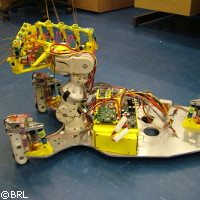Whiskered robot rat gives tactile sensing a boost
Whiskers are an integral component of a rat's life. Without them, rats would have a hard time navigating in their world, as well as orientating and balancing themselves. Now scientists from the Bristol Robotics Laboratory (BRL) - a partnership between the University of the West of England Bristol (UWE Bristol) and the University of Bristol (UoB) - in the UK have developed the innovative 'SCRATCHbot' robot rat that is able to search and identify objects by using its whiskers. SCRATCHbot is part of the EU-funded ICEA ('Integrating cognition, emotion and autonomy') project, which falls under the Sixth Framework Programme's (FP6) 'Information society technologies' (IST) Thematic area. Financial support for the project amounts to EUR 5.8 million. ICEA, which will end in December 2009, is targeting the development of biologically inspired artificial intelligence systems. 'Our project has reached a significant milestone in the development of actively-controlled, whisker-like sensors for intelligent machines,' explained Professor Prescott from the Department of Psychology at the UK's University of Sheffield. Professor Prescott is cooperating with the BRL to design artificial touch technologies for robots that will fuel our understanding of how the human brain controls the sensory systems' movements. 'Although touch sensors are already employed in robots, the use of touch as a principal modality has been overlooked until now,' he pointed out. 'By developing these biomimetic [i.e. nature-mimicking] robots, we are not just designing novel touch-sensing devices, but also making a real contribution to understanding the biology of tactile sensing.' The scientists were encouraged to develop the innovative technology by looking at how animals use touch in their environment. Nocturnal creatures (animals that become active during the night) benefit immensely from this physical sense because their vision is limited in the dark and in poorly-lit areas. Rats are nocturnal by nature; they effectively use their whiskers to explore their surroundings. By using precise rhythmic sweeping movements of their whiskers, they can accurately determine the shape, position and texture of objects, according to the scientists. Once this happens, they can then use the information to develop environmental maps. From a conventional standpoint, vision is a key component for robots when they need to identify objects. This new technology is unique in that it depends exclusively on sophisticated touch technology. The robot is able to operate in spaces where the use of vision is not possible, such as smoke-filled rooms. 'For a long time, vision has been the biological sensory modality most studied by scientists. But active touch sensing is a key focus for those of us looking at biological systems which have implications for robotics research,' said Dr Tony Pipe from the Department of School of Electrical and Computer Engineering at the UWE Bristol and BRL. 'Sensory systems such as rats' whiskers have some particular advantages in this area. In humans, for example, where sensors are at the fingertips, they are more vulnerable to damage and injury than whiskers,' he added. 'Rats have the ability to operate with damaged whiskers, and in theory broken whiskers on robots could be easily replaced without affecting the whole robot and its expensive engineering.' The future looks bright. The scientists highlighted how the new technology has the potential for a number of further applications where vision is seriously limited. 'Future applications for this technology could include using robots underground, under the sea, or in extremely dusty conditions, where vision is often a seriously compromised sensory modality,' Dr Pipe underlined. 'This research builds on previous work we have done on whisker sensing.' SCRATCHbot is now being presented at a global workshop that is studying how robots can help humans understand the brain's mechanics.
Countries
United Kingdom



